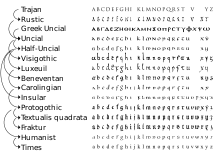Insular G



Insular G (majuscule: Ᵹ, minuscule: ᵹ) is a form of the letter g somewhat resembling an ezh, used in the medieval insular script of Great Britain and Ireland. It was first used in the Roman Empire in Roman cursive, then it appeared in Irish half uncial (insular) script, and after it had passed into Old English, it developed into the Middle English letter yogh (Ȝ ȝ). Middle English, having reborrowed the familiar Carolingian g from the Continent, began to use the two forms of g as separate letters.
Letter
[edit]
The lowercase insular g (ᵹ) was used in Irish linguistics as a phonetic character for [ɣ], and on this basis is encoded in the Phonetic Extensions block of Unicode 4.1 (March 2005) as U+1D79. Its capital (Ᵹ) was introduced in Unicode 5.1 (April 2008) at U+A77D. The insular g is one of several insular letters encoded into Unicode. Few fonts will display all of the symbols, but some will display the lowercase insular g (ᵹ) and the tironian et (⁊). Two fonts that support the other characters are Junicode and Tehuti.

| Insular letters in Unicode[1][2] | ||||||||||||||||
| 0 | 1 | 2 | 3 | 4 | 5 | 6 | 7 | 8 | 9 | A | B | C | D | E | F | |
| U+1ACx | ◌ᫌ | ◌ᫍ | ◌ᫎ | |||||||||||||
| U+1D7x | ᵹ | |||||||||||||||
| U+1DDx | ◌ᷘ | |||||||||||||||
| U+204x | ⁊ | |||||||||||||||
| U+2E5x | ⹒ | |||||||||||||||
| U+A77x | Ꝺ | ꝺ | Ꝼ | ꝼ | Ᵹ | Ꝿ | ꝿ | |||||||||
| U+A78x | Ꞃ | ꞃ | Ꞅ | ꞅ | Ꞇ | ꞇ | ||||||||||
| U+A7Dx | Ꟑ | ꟑ | ||||||||||||||
Notes
| ||||||||||||||||
The insular form of g is still used in traditional Gaelic script.
Turned insular g
[edit]A turned version of insular g (Ꝿ ꝿ) was used by William Pryce to designate the velar nasal ŋ.[1]
See also
[edit]References
[edit]- ^ Everson, Michael (2006-08-06). "L2/06-266: Proposal to add Latin letters and a Greek symbol to the UCS" (PDF).
External links
[edit]- Drawing an insular G (here mistaken for yogh)
- Michael Everson's article On the derivation of YOGH and EZH shows insular g in several typefaces.
| Alphabets (list) | |||||||||
|---|---|---|---|---|---|---|---|---|---|
| Letters (list) | |||||||||
| Multigraphs |
| ||||||||
| Keyboard layouts (list) | |||||||||
| Standards | |||||||||
| Lists | |||||||||
Text is available under the CC BY-SA 4.0 license; additional terms may apply.
Images, videos and audio are available under their respective licenses.
